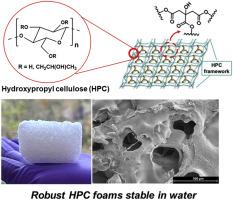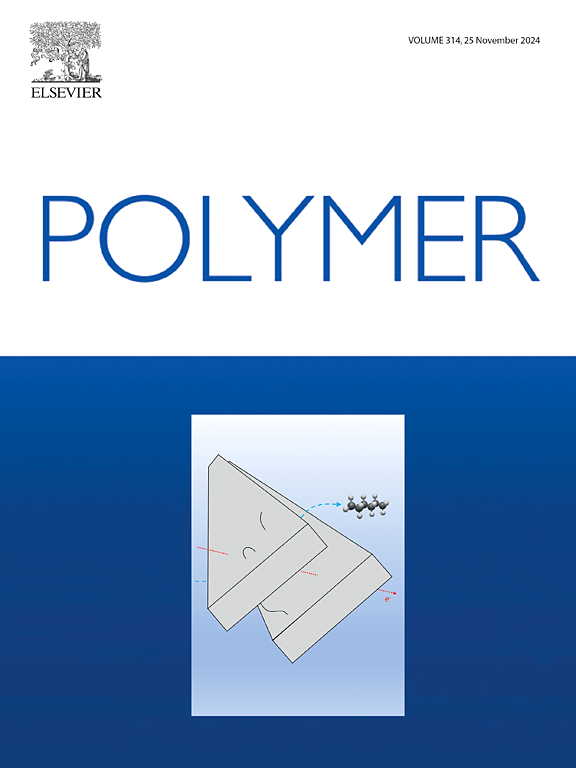由羟丙基纤维素构成的生物聚合物泡沫:制造、水稳定性和机械完整性
IF 4.1
2区 化学
Q2 POLYMER SCIENCE
引用次数: 0
摘要
我们描述了由羟丙基纤维素水溶液形成的生物聚合物泡沫的制造过程,其中冷冻诱导的相分离和溶剂去除产生了坚固的泡沫结构,这种结构在空气中和潮湿时具有弹性,并且在水完全饱和时能够稳定地反复压缩。通过相分离、孔隙形成和共价交联机制,我们发现了制备微孔 HPC 泡沫的有效方法,这种泡沫即使长时间(至少数月)暴露在水中也不会凝胶化。采用多功能羧酸交联剂可使泡沫在干燥或潮湿时保持其完整性,而作为添加剂的 α-纤维素的存在则进一步增强了泡沫的机械完整性,并提供了一种调节弹性的方法。发泡过程中交联剂的用量对泡沫的稳定性和吸水性有很大影响,而聚合物交联剂则能使硫代甜菜碱齐聚物插入泡沫中。值得注意的是,HPC 溶液和凝胶的热转变特性在泡沫形式中被证明是有效的,这体现在利用压缩和热机制从饱和 HPC 泡沫中释放水分。本文章由计算机程序翻译,如有差异,请以英文原文为准。

Biopolymer Foams Composed of Hydroxypropyl Cellulose: Fabrication, Aqueous Stability, and Mechanical Integrity
We describe the fabrication of biopolymer foams formed from aqueous solutions of hydroxypropyl cellulose, whereby freezing-induced phase-separation and solvent removal yields robust foam structures that are elastic in air and when wet, and that are stable to repeated compression when fully saturated with water. Through mechanisms of phase-separation, pore formation, and covalent crosslinking, we discovered effective methods to prepare microporous HPC foams that resist gelation even when exposed to water for long time frames (at least months). Employing multifunctional carboxylic acid crosslinkers allowed the foams to maintain their integrity when dry or wet, while the presence of α-cellulose as an additive further augmented their mechanical integrity and provided a means to adjust elasticity. The amount of crosslinker employed in the foaming process significantly impacted foam stability and water uptake, while polymeric crosslinkers enabled insertion of sulfobetaine zwitterionic moieties into the foams. Notably, the thermal transition characteristic of HPC solutions and gels proved operative in foam form, as seen in release of water from a saturated HPC foam using a combination of compressive and thermal mechanisms.
求助全文
通过发布文献求助,成功后即可免费获取论文全文。
去求助
来源期刊

Polymer
化学-高分子科学
CiteScore
7.90
自引率
8.70%
发文量
959
审稿时长
32 days
期刊介绍:
Polymer is an interdisciplinary journal dedicated to publishing innovative and significant advances in Polymer Physics, Chemistry and Technology. We welcome submissions on polymer hybrids, nanocomposites, characterisation and self-assembly. Polymer also publishes work on the technological application of polymers in energy and optoelectronics.
The main scope is covered but not limited to the following core areas:
Polymer Materials
Nanocomposites and hybrid nanomaterials
Polymer blends, films, fibres, networks and porous materials
Physical Characterization
Characterisation, modelling and simulation* of molecular and materials properties in bulk, solution, and thin films
Polymer Engineering
Advanced multiscale processing methods
Polymer Synthesis, Modification and Self-assembly
Including designer polymer architectures, mechanisms and kinetics, and supramolecular polymerization
Technological Applications
Polymers for energy generation and storage
Polymer membranes for separation technology
Polymers for opto- and microelectronics.
 求助内容:
求助内容: 应助结果提醒方式:
应助结果提醒方式:


